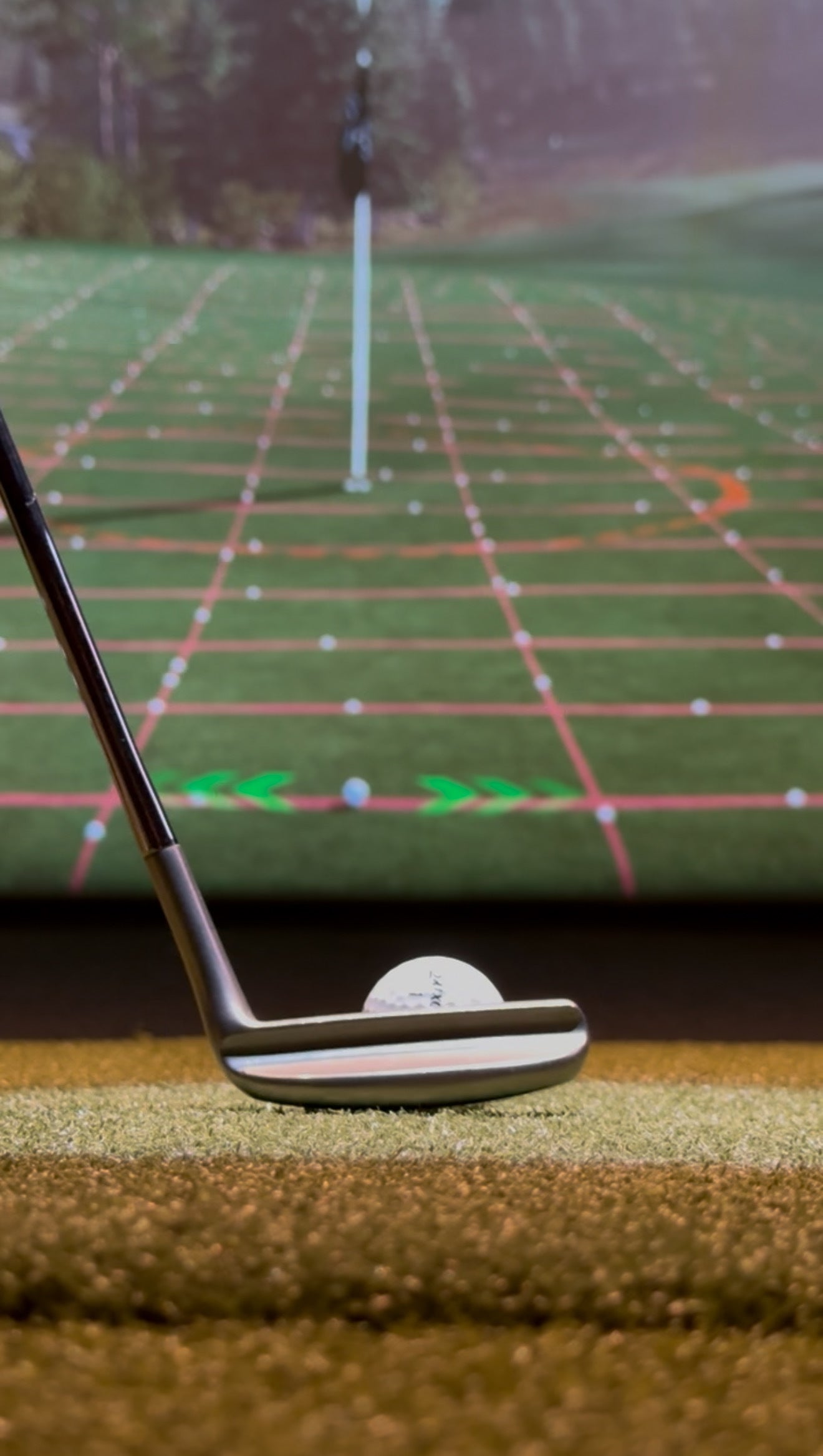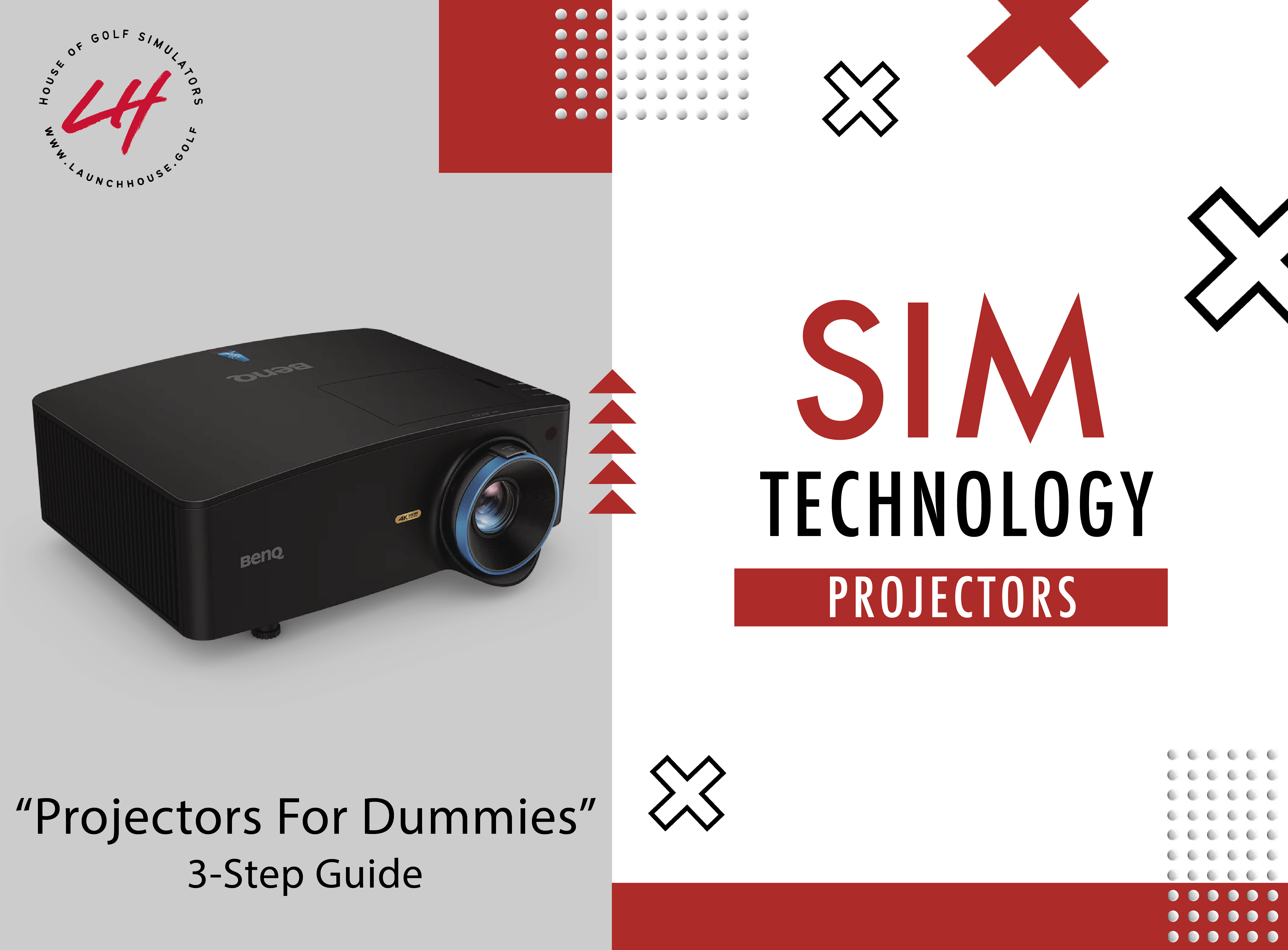Projectors can cause a lot of confusion. With various screen sizes and available mounting locations, selecting the right projector for a golf simulator is challenging.
At Launch House, we have created a simple 3 step guide to determine what projector will work for your home golf simulator. Before we get into the 3 steps, lets define some terminology that will help you make a decision.
Aspect Ratio:
The ratio of the width:height of an image or screen. Ex; 16:9 could be 16' wide and 9' tall. 4:3 could be 12' wide and 9' tall.

The most common aspect ratios you will find for golf simulator impact screens are 16:9 and 4:3. You may also see 1:1 and 16:10.
16:9 is the standard HD/UHD dimension for TV's and Monitors. It will give a nice wide screen area, but it isn't a common enclosure size for people with a smaller space.
4:3 is a common enclosure size for residential golf simulators, because it works better in smaller spaces. You want the biggest screen you can possible, and your space will determine if that's 4:3 or 16:9.
Throw Ratio:
The relationship between the distance the projector lens is to the screen, to the width of the screen, distance:width Ex; A short throw projector with a 0.5:1 throw ratio. If this projector lens was 8 feet from the screen, the projected image would be 16 feet wide.

You need to pay attention to your aspect ratio if you are using 4:3 because most new projectors native resolution is 16:9. 0.5:1 is easy math in 16:9 but it changes when you put your projector into a 4:3 aspect ratio.
To simplify all of this math, head over to Projector Central they have a fantastic throw calculator that can easily determine the mounting position of your projector for any given screen size. Don't forget to select your correct aspect ratio in the drop down!

3 Step Guide to Golf Simulator Projectors
Step 1 - Enclosure / Screen Size
You must decide on your enclosure size first. Refer to our article on choosing the best enclosure size for your space. Once you get settled on your enclosure dimensions, we can get into selecting a projector to fill that screen from corner to corner with ease.
Once you are set on the golf simulator enclosure that will fit your space. You should learn what the viewable screen dimensions are. Viewable screen area is going to help you fine tune how far a projector will mount from the impact screen.
Step 2 - Available Mounting Locations
Determine what your available mounting locations will be. You can hard mount a projector to the ceiling, which is the ideal option, this gives the best aesthetic and keeps it safe. You also have the option of placing it on the floor, within a protective case, or set on a surface (table, tripod) off to the side (this requires a lot more attention to projector specs, and the projector must have horizontal keystone).
Mounting to the Ceiling
In order to mount a projector to the ceiling, there must be material that can accept mounting screws for a projector mount (studs, enclosure piping, custom panel, beams, etc.).

When mounting a projector to the ceiling, we recommend the distance to be between 8'-14' from the screen. 8' is the minimum, to prevent hitting the projector with a golf ball. 14' being the maximum, beyond this distance you can run into shadows being cast by the golfer onto the screen.
Floor Mounts or Table Top
To mount a projector on the floor, the projector must be in between the golfer and the screen. This generally requires the projector to be a short throw variant. This cuts out a lot of your options, but there are several on the market in this category. These generally have a throw ratio of 0.5:1.

The projector being on the floor poses some challenges. In order to make sure your projector doesn't get damaged, it must be protected somehow. There are some commercially available projector cases designed specifically to be used on the floor in a golf simulator. You could also DIY a case if you have the time and desire. These floor cases do a good job at protecting the projector from being damaged by a golf ball, but they pose a tripping hazard, trap in excess heat which can lead to overheating in hot environments, and your sim won't look as clean as it would if it were mounted overhead.
The least desirable option would be to mount the projector on a table or chair off to the side, or "offset". This is definitely possible, and can be a quick fix if you just can't wait to test your simulator out. But to get the image to look right, the projector will have to have a "horizontal keystone" adjustment option, which isn't common in all projectors, so be sure to look for that if you go this route.
How far from the screen should the projector be mounted?
You have to know this answer before you make your purchase. And this is not an answer anyone can give you, without doing some calculations first. Luckily, there is a tremendous resource available to you at www.projectorcentral.com
3 Most Important Considerations:
- Size of the Screen
- Aspect Ratio of the Screen
- Projector Throw Ratio
As long as you know your screen size and aspect ratio, and your available mounted locations, you can plug those numbers into their calculator (image below).
For overhead mounted projectors, we recommend anything from 8'-14' from the screen. Keep this in mind if you also have an overhead mounted launch monitor.
Step 3 - Budget
Yes, the dreaded term everyone hates, "budget". You have to be realistic about how much money you have invested into your simulator build, and determine what amount of money you are willing to allocate to the projector alone.
If money is no concern, there are several options for you to get the best of the best. Laser 4K Projectors would be in your wheelhouse.
If you want the best bang for your buck, and are trying to be responsible about getting the right projector for the quality of build you have, there are a lot of specs you may be able to live without.
Laser Projectors
These will be at the top of the price range. They offer higher contrast, and usually have more lumens (brighter) than their counterparts that use a traditional bulb. They run quieter, cooler, last longer and draw less power as well. They look great, but do you really need one? No, you don't. Its one of those things that's nice to have, but you will likely not get the return on investment you were hoping for.
Bulb Projectors
The old workhouse. These are much more common, giving you a lot more options for various price points and desired features. The bulbs are usually rated for a few thousand hours, which for most is years of use, and the bulbs are actually a pretty cheap replacement as long as the projector isn't discontinued.
If you are building your first golf simulator, or don't have ample money to allocate to a projector, this should be your go-to option. There are thousands of commercial sim facilities around the world using bulb projectors, and the customers wouldn't know the difference if one was laser or not.
4K vs 1080p
Here at Launch House, we run commercial facilities as well as perform installs for customers in residential/commercial environments. A lot of people ask us if they should buy a 4K projector. We have a simple answer, if you want to use the projector for golf as well as gaming or watching movies/sports, 4K may be the route to go. So far, as of 2024, the graphics in golf simulation software still leave a bit to be desired, and the only difference you will notice between 4K and 1080p is the clarity in the fine details such as text or grass.
4K projectors not only run about 2x the price of 1080p options, but they require you to step up the caliber of PC you have running your system with a more powerful graphics card. Don't overthink this area, its really not all that important. You will have just as much fun hitting darts into greens on a 1080p projector, and you may be able to allocate that excess money into a nicer hitting mat (very important aspect of every golf simulator).
RECAP (TLDR):
- Decide on your Enclosure Size and determine the viewable screen area
- Evaluate your room and determine where a projector can be mounted.
- Find a projector that works with your budget, that will fill your image based on where it will be mounted.



Share:
Guide to Golf Simulator Components